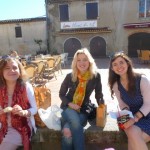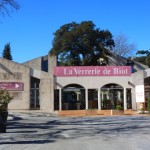On a beautiful Thursday in late March, I went to this great village, Biot, which is about 30 minutes from Nice, where they make Handblown glass- Julia Childs mentioned it in her My Life in France book, as she and Paul had a set of glasses from Biot. I’d visited with one of my host families 3 1/2 years ago while on vacation in the Cote d’Azur, but we only visited one of the glass-making places. Yesterday with the girls from my program, we visited the big one I’d been to before, La Verrerie de Biot. I was MUCH more impressed by the small place, Verrerie Ferinelli, where you could stand about 4 ft away from the men making the glass stuff as they smoked their cigarettes and made amazing works with seeming ease. The prices were also significantly lower there than at the larger verrerie down the road, and I found the quality to be much higher, the glasses had a better distribution of thickness and uniformity, and the colors seemed to be stronger, too. They just don’t get the tour buses flowing through like the large place does (literally, a tour bus FULL of mostly white-haired folks pulled in and unloaded while my friends and I were in the glass museum). If you’re able to visit here, it’s certainly worth a trip to visit the large workshop to see their museum section and the different types of products, and the workshop space has a good explanation of how they make the glass items; but to get an up-close look of the process, I definitely suggest going to Verrerie Ferinelli, which was about 1 km towards the village center from the large Verrerie which has all the signs pointing to it.
We also checked out this small gallery, Pierini Verrerie, which was across the street from Verrerie Ferinelli. Here, they had some truly breath-taking works of art from four different artists, but the majority of the work is created by the Father-Son team who owns the workshop and appears to live right behind it. These are works going for well over 2000 euros sometimes, but I can only imagine the kind of mastery required to produce these pieces! I didn’t get any photos of the inside of the shop, but I did take photos of the patio, where they had several large pieces. They don’t have demonstrations everyday like most of the other workshops, but it’s certainly worth a visit one day when they do!
We had taken a train from Nice and then a local bus to get to the village center. Once there, we learned that most of the workshops were, in fact, down the hill- “A 15 minute walk, not too bad” say the shopkeepers in the village. We were in a group of seven, and a few girls were on a time crunch, so we took the city bus back down the hill to the part of town where you find the workshops. After visiting the large Verrerie, three of the girls headed back to the train station to make their way back to Nice. The remaining four of us then went on the visit the small workshops, and then we decided to return to the village center to check it out a bit more, as it was really charming and the people seemed very friendly. The town has a great, slow-paced, small-town vibe. It is unmistakably a little bit touristy, but that doesn’t seem to overwhelm its own character.
Once in the village, we stopped in a few shops, where we were delighted to find great souvenirs, knickknacks, regional products, and stuff that everyday locals go into buy, as well. It was clear that this town doesn’t just gut itself for the tourists; it still stands to serve its own residents, which is something often difficult to find in regions as touristic as the French Riviera. We had decided to get a café before heading back for the evening, and we stumbled upon this great cafe/bar/restaurant that you would walk by without blinking unless you looked directly at it. I had honestly already walked by it at least 3 times that day and not noticed. We said hello to the owner/server (same thing in towns like this), entered and saw one older gentleman sitting at a table. The place was decorated with great taste, large beige tiled floors, beautiful multi-colored glass chandeliers, and a rustic, woodsy feeling that really marks the ‘arrière pays’ of the Niçois region. Of course, all the light fixtures were made of hand-blown glass. We asked if we could sit upstairs, as there was a funky little overlook (and a large, random lion plush toy guarding the stairwell at the top), and as confused as the server seemed, he gave us the go-ahead (“si vous voulez, allez-y!”).
We then headed back to the bus stop to make our way to the train station, but not before stopping in a cavernous (literally, underground and built into an old cave) macaron store, where the shopkeeper informed us of the upcoming Medieval festival in two weeks. For the weekend of April 5-7, the entire town will be putting on a festival with a ‘theme of the gastronomy,’ and advertises ‘culinary treasures,’ a medieval tavern, demonstrations and workshops. The shopkeeper told us we could even dress up in costume, or rent costumes while there!
The next day, I had three classmates (real, live French girls!) over to the house to make macarons! We started cutting and mixing at about 1:30pm, and didn’t finish spreading the ganache onto the cookie shells until about 7pm. Albeit, we made about 100+ full macarons (so, more than 200 individual cookie sides!). It was great! My friend Roxanne cut herself in the first 5 minutes, but soldiered on until the last bit of ganache was spread. I think/hope it could be one of those defining moments when people become friends, not just friendly classmate, you know? Making that extra effort to meet up outside of school, go to someone’s home and make a mess in their kitchen while exchanging family tales and tastes of music. My host mom was a little shocked when she came home to find 200 little round macaron pieces being created, cooked and connected, though. I had asked the day before if I could have friends over to make macarons, but she didn’t realize just how many macarons we were going to make! I think we over-estimated the number by just a bit- no one was upset by this in the least, however 😉
Bisous,
Simone



